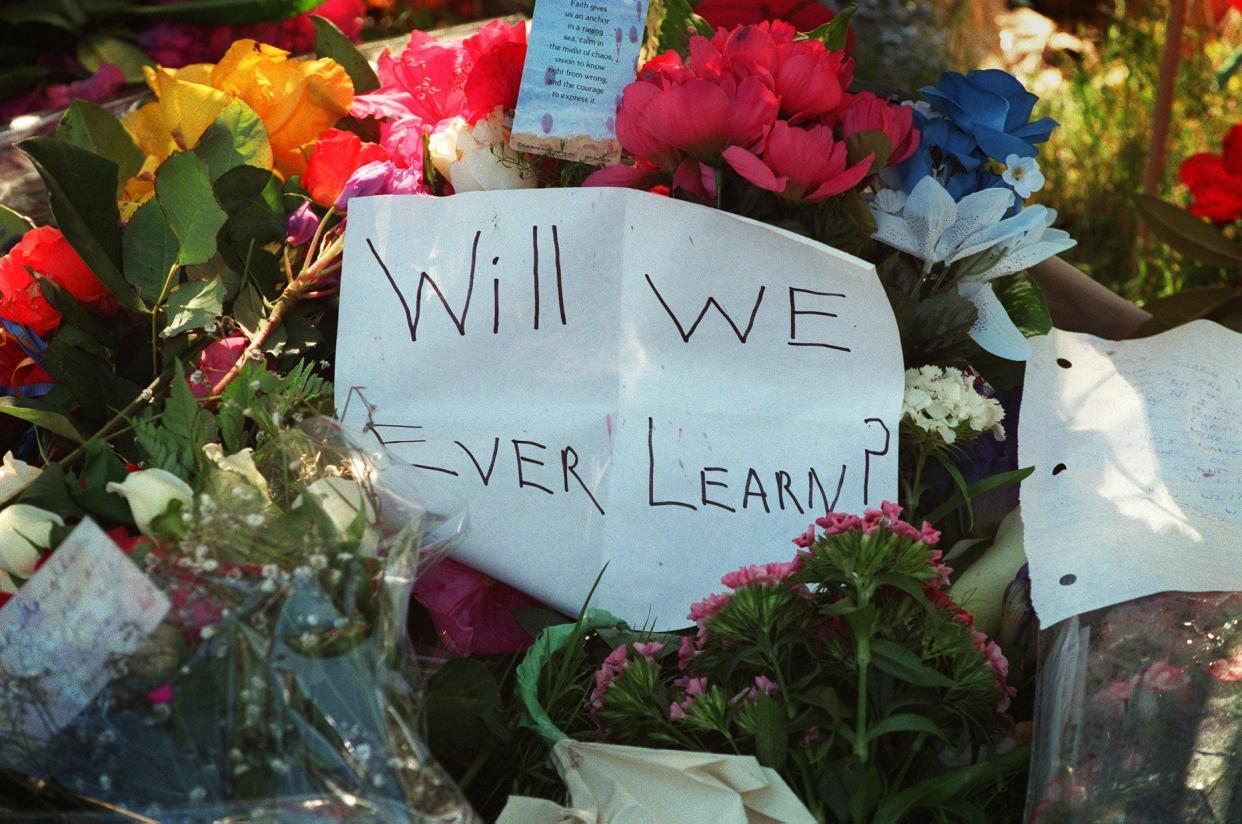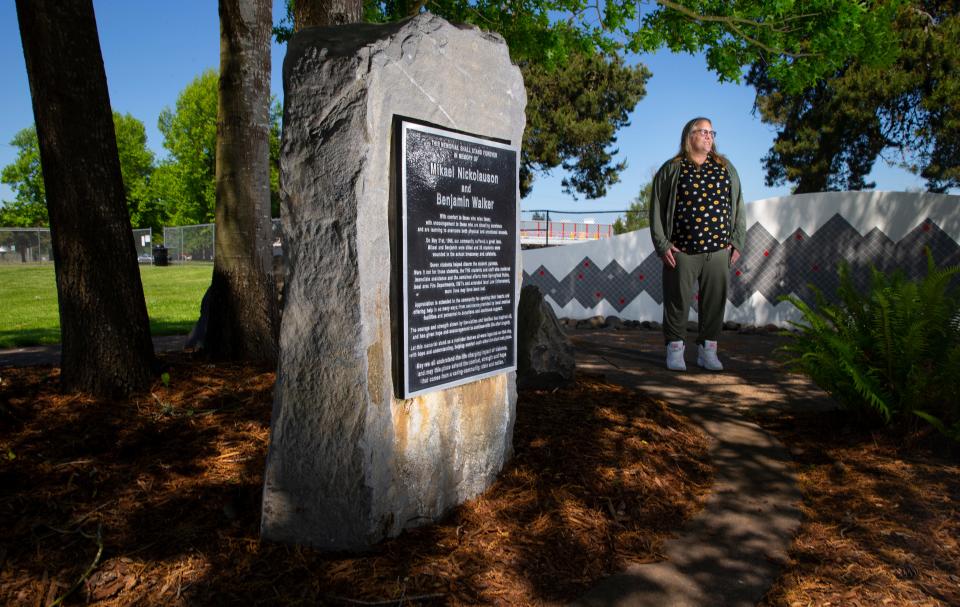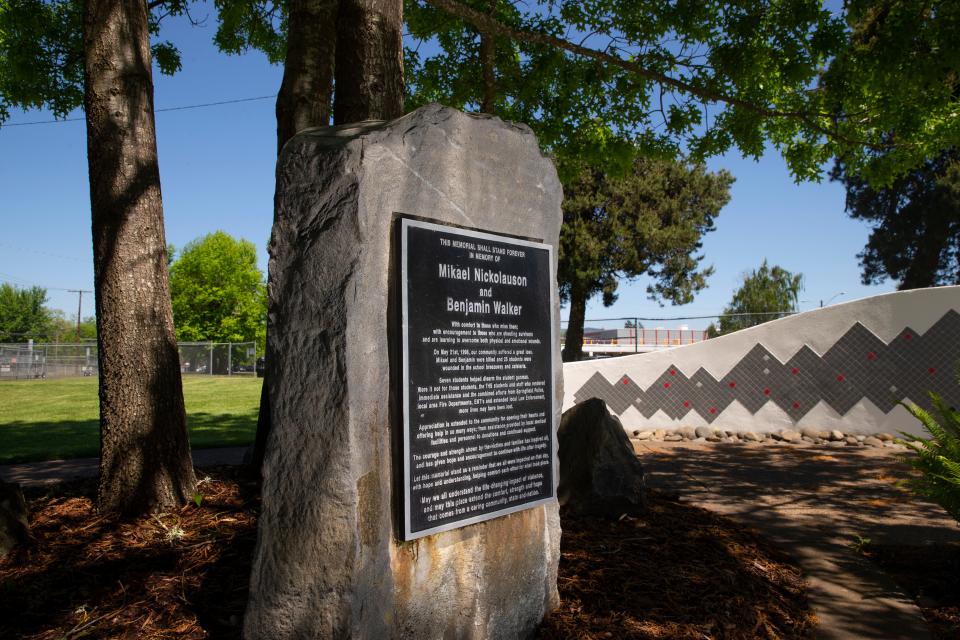25 years later: Healing from the Thurston High shooting

Content warning: This article discusses gun violence and the Thurston High shooting of 1998, which may be triggering for some readers.
"May we all understand the life-changing impact of violence."
This quote is etched into the stone at Springfield's Thurston High memorial, which marks the tragedy that occurred at the school exactly 25 years ago.
On that day, 25 students were injured and two students lost their lives during one of the largest mass school shootings in modern history. The shooting came almost a year before the Columbine High School massacre in Colorado that left 15 dead and 24 wounded.
The memorial honors Mikael Nickolauson and Benjamin Walker, who were killed at the school on Thursday, May 21, 1998.
At the time, the shooting shocked the nation and spurred demands for action surrounding guns and youth mental health that have become increasingly frequent in recent years following each subsequent school shooting.
But as the nation moved on to the horrors of Columbine, Virginia Tech, Sandy Hook, Umpqua Community College, Parkland, and Uvalde's Robb Elementary, many in the Springfield community have struggled to heal, especially those directly affected.
More: Remembering the victims of the May 1998 Thurston shooting
James Ready, now 41, was a junior at Thurston in 1998.
He was in a wheelchair, having broken his leg the month before. He lived across the street from the school, and wheeled himself there that morning. He remembered skipping the cafeteria that morning, anticipating seeing his friends at lunch.
Ready went into the band room instead. He remembered greeting his friend Nickolauson, who would be killed later that day.
Grace Sanders, now 42, went to the cafeteria where she sat with her friend at one of the lunch tables.
Both Ready and Sanders recalled hearing gunshots and thinking they were fireworks. Student government campaigns were in full swing, and they thought it had something to do with that.
At the time, they had heard about a handful of school shootings, but this was years before active shooter drills and school lockdowns became routine.
When Ready went to look outside the band room to see what was going on, a crowd surged past, bending the door off its hinges. He remembers a bullet whizzing past his head just as a friend pulled him back through the doorway in his wheelchair.
He saw several students shot in the hallway, including Walker.
In the cafeteria, where much of the violence would occur, Sanders remembers everyone ducking under lunch tables, which provided little shelter. She remembers being frozen, like a deer in headlights.
She remembers the gun being pointed toward her.
"I looked, and he aimed the gun at me, and it clicked. He ran out of bullets," Sanders said.
The perpetrator, Kipland Kinkel, had been suspended pending an expulsion hearing for being in possession of a loaded, stolen handgun. He killed his parents, Bill and Faith, who were both teachers, at their home the day before returning to school with a rifle and two pistols.
Seeking release: 25 years after Thurston High shootings, Kip Kinkel and attorneys file new petitions
Most of the students were shot in the cafeteria before injured student Jacob Ryker and several other students tackled Kinkel while he tried to reload and held him until police arrived.
Kinkel is currently serving a 112-year prison sentence.
Healing and facing the trauma
In the days and weeks that followed the shooting, Ready described school as almost pointless. He found it hard to motivate himself to get to school. Schoolwork was minimal. There was little time left until the end of the school year. The school parking lot was crawling with news media. Counselors were on call as needed.
Sanders remembers meeting with counselors, trying to cope with what she witnessed that day.
Ready said he tried to ignore the trauma at first.
"It's not that I didn't have people to talk to. I just had no idea how to process, and I just didn't really want to acknowledge it, because acknowledgment meant I would have to essentially relive it," Ready said. "In that first five years, if I were to retell it, I would be experiencing it on an emotional level. And so I just chose to ignore it. Obviously, my parents were concerned, and even my friends would definitely make sure that I was okay. But in terms of seeking help, I just chose not to."
Eventually, while attending the University of Oregon, Ready began attending free on-campus counseling services. He said group and individual counseling helped him get to a point where he no longer feels emotionally destabilized by remembering what happened.
Ready has also been able to talk with friends about his trauma, saying those who share similar experiences are easier to relate to.
He remembers every detail about that day, except for a moment after the shooting when he wheeled by the cafeteria. He knows he looked inside and was frozen there, but still cannot remember what he saw. He assumes this was an automatic trauma response that blocked the image from his memory.
"The following couple of years, it's just like, how does somebody go back to normal? What is normal after something like that?" Ready said. "Of course, sadly, nowadays that is the normal."
Ready said hearing about gun violence can still bring up bad memories, but the Columbine shooting a year later was especially hard.
Sanders also said she struggles every time there's another school shooting, with some making a bigger impact than others.
"I still get triggered," she said. "That doesn't really go away. With the shootings that have been happening lately, it's been tough because I was hoping there would be some, like, last event. It seems like that's not the case."

According to research by the Washington Post, there have been 380 school shootings since 1999. Since Columbine, more than 352,000 students have experienced gun violence at school.
Even now, although Ready is no longer in regular counseling, he still notices himself keeping a smaller friend circle, avoiding getting too close to others.
Ready said he was fairly close with Nickolauson. He said Nickolauson was the one who first introduced him to eating ranch on pizza. They were in a group that would play fantasy role-playing games together after school. They had known each other since middle school.
"To an extent, I just stopped making friends because I didn't want to lose anyone," Ready said. "I'm definitely friendly to even people I haven't met before. It's just, sometimes I'll catch myself realizing that I do have a very small group of friends, and I wonder if that's technically on purpose or a little bit of a defense mechanism."
Mental health now
Mental health resources have changed across the country since the turn of the century; this is also true for Springfield Public Schools.
Dr. Brian Megert, special programs director for Springfield, said expectations have changed significantly for what role the schools play in providing mental health resources.
Teachers and staff now receive training to ensure instruction and interactions are culturally responsive and trauma-informed with a focus on restorative practices. There is generally an emphasis on supports and interventions to help students in need, as opposed to enforcing punitive action.

In addition to the district's six registered nurses, dozen psychologists, and middle and high school counselors, Springfield works with many community partners that offer extra resources. Several offer therapy services at school, including HOOTS, through White Bird Clinic, which visits high schools four times a month.
"There was more and more requests for mental health services in our school system," Megert said. "And I think what we've realized over time is that we would never really be able to get up to the level of capacity with internal staff, which is why we turn to our community partners."
This trend toward mental health resources is not attributed to gun violence, but interventions and methods have been developed in recent years to try to prevent threats in the school setting.
Megert said Springfield uses Lightspeed Alert, a school violence prevention software that flags any harmful language such as threats in district-affiliated email accounts. District staff then look at the language, and talk with parents if they believe intervention is needed.
"We have a variety of ways to keep an eye on our kids, and a variety of services that we can provide if we see any issues around behavioral safety," Megert said.
Megert said parents and students can reach out to their school administration if they're seeking mental health resources. He said for any students that may not be able to pay for mental health services, Springfield offers funding to cover services through their community partners.
How do we remember and honor?
The public memorial just outside of Thurston High's gates was unveiled five years after the shooting, in 2003. It features a mosaic wall and an engraved stone dedicated to Nickolauson and Walker, as well as all those who have experienced gun violence. In the past, community members have left flowers and notes at the site.
Nowadays, Thurston students who were born years after the shooting hang out in the area during lunch and before and after school. It offers a shady place to rest as well as a place to remember the tragedy.
When asked how the community should best remember the Thurston shooting, Ready said he didn't have a real answer.
"In terms of like a communal, collective standpoint, do we still mention it 25 years later? How many people have moved away? How many people now have families? How many people, especially in this day and age, have children in that same (age) group by now?" Ready asked. "Obviously, you shouldn't not mention it, because it affected people, and especially now that it's happening way too often."
Ready doesn't plan on attending any memorial events.
"I'm trying to move on as much as I can, but I would never in a million years judge people who did go," Ready said. "Everybody deals with things in their own way."
Thurston High has no coordinated memorials or vigils planned. There have been community-organized remembrance events in the past, but the Register-Guard was unable to find any announcements for anything public to mark 25 years since the shooting.
Sanders said this was disappointing. She said she attended the candlelight vigil held at a park near Thurston on the 20th anniversary.
Sanders said she wishes there was some sort of vigil or memorial to attend.
"I think that's important to remember that at one point in time, we had something horrific happen, but the community came close together and supported one another," Sanders said.
Mental health resources
Whitebird Crisis Service Center: 541-687-4000 or 1-800-422-7558
Eugene Crime Victim and Survivor Services: 541-682-8432
Willamette Valley Counseling: 541-636-0885
Lane County Victim Services: 541- 682-4523 or lanecounty.org/government/county_departments/district_attorney_s_office/victim_services_program
Portland Office of Violence Prevention: portland.gov/community-safety/oyvp/programs-services
National Domestic Violence Hotline: 800-799-7233
National Suicide Prevention Hotline: 988
Miranda Cyr reports on education for The Register-Guard. You can contact her at mcyr@registerguard.com or find her on Twitter @mirandabcyr
This article originally appeared on Register-Guard: 25 years later: Healing from the Thurston High School mass shooting

